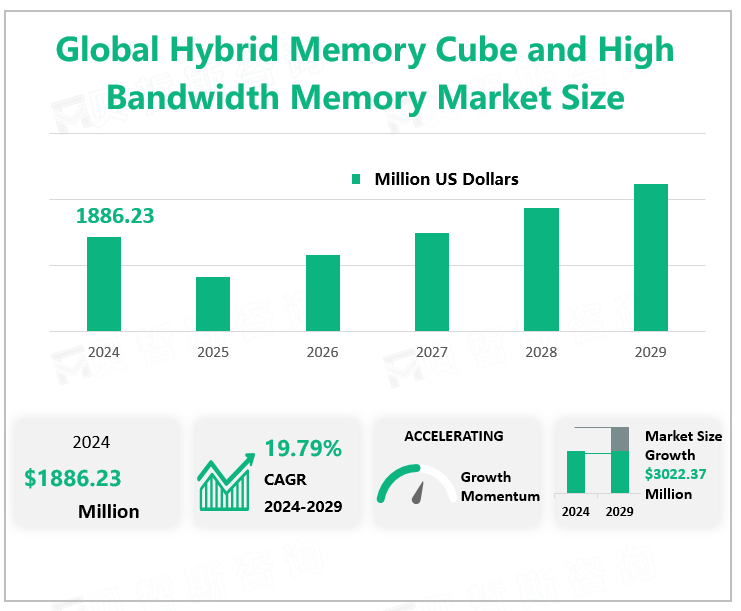Global Hybrid Memory Cube and High Bandwidth Memory Market Overview
According to Global Market Monitor, the global hybrid memory cube and high bandwidth memory market size is $1886.23 million with a CAGR of 19.79% from 2024 to 2029.
The Hybrid Memory Cube (HMC) is the high-performance RAM interface through-silicon via (TSV) technology by connects the multiple memory arrays to top of one another. It uses standard DRAM cells for memory implementation. The High-bandwidth Memory (HBM) is also the RAM interface for 3D stacked SDRAM. It is used in combination with network devices and graphic accelerators. Both memory buses are capable of providing higher bandwidth with lower power consumption. It is widely applicable in graphics designing, in the field of networking, and others. HMC and HBM are appropriate for Big Data applications since they offer super quick stockpiling execution. These advancements additionally adequately address the presentation, transfer speed, and perseverance necessities of Big Data applications.
Rising adoption of artificial intelligence (AI)
The rising adoption of artificial intelligence (AI), broadly referring to the intelligence displayed by machines contrary to the natural intelligence demonstrated by humans, across various facets of technology applications is building momentum from high-tech memory devices. AI adoption is soaring on an ongoing basis amid escalating computational capacity in the 'Cloud', and improvements in sophisticated algorithms, while generating parallel opportunities to advanced hardware devices including high-performing memory and processors.
Electronic device miniaturization is another major growth driver for HMC/HBM technology. As MEMS devices are small, they require advanced memory solutions made in extremely low-footprint designs, but with higher memory capacities, for which HMC/HBM can offer potential alternatives. HMC and HBM markets also stand to gain from high growth momentum in the stacked DRAM vertical, gauged through the wider uptake of 3D TSV technology in DRAM fabrication. Leading DRAM memory vendors are prioritizing 3D layer stacking with TSV technology to develop high-quality memory devices to address consumers' growing high-performance computing needs while creating ample space for HMC and HBM, the stacked DRAM memory solutions.

Regional Market
The high adoption of HMC and HBM memories in North America is largely due to the growth in high-performance computing (HPC) applications that require high-bandwidth memory solutions for fast data processing. The demand for HPC in North America is growing owing to the increasing market for AI, machine learning, and cloud computing. The interest in HPC in North America is becoming inferable from the expanding market for AI, AI, and distributed computing. Other key tech organizations, for example, Google, Amazon, and Microsoft are additionally settled in the US and have served to drive the interest for high-performing CPUs in workers and supercomputers. The major drivers for the rapid growth of the HMC and HBM market in APAC are the growing number of data centers and servers, increasing shipments of network equipment, and the rising number of manufacturing activities in the enterprise storage and consumer electronics sectors. The strong economic growth and growing demand for high-density memories are also expected to drive the HMC and HBM market in the APAC region.
|
Drivers |
Growing Big Data |
|
Rising adoption of artificial intelligence (AI) |
|
|
Increasing demand |
|
|
Growing need for high bandwidth, low power consumption, and highly scalable memories. |
|
|
Challenges |
High new entrants’ barriers |
|
Fluctuations in raw material prices |
|
|
Thermal issues caused by high levels of integration |
We provide more professional and intelligent market reports to complement your business decisions.